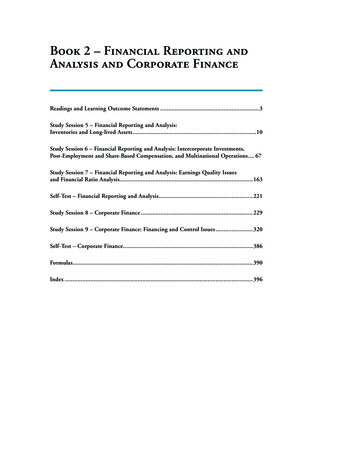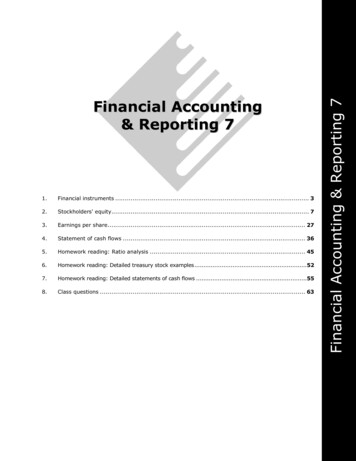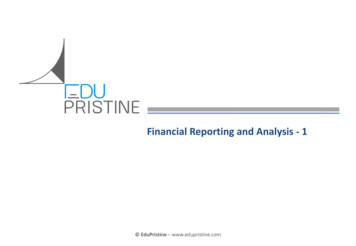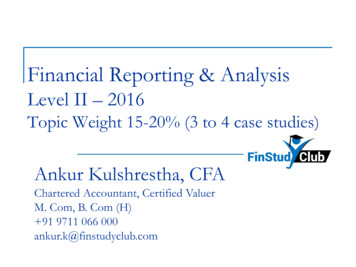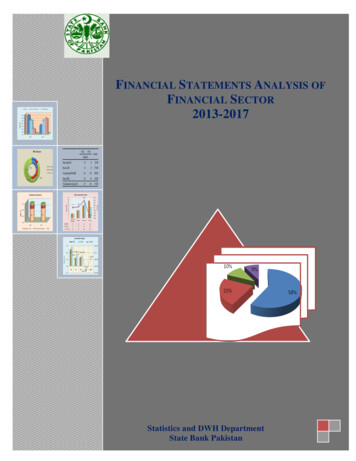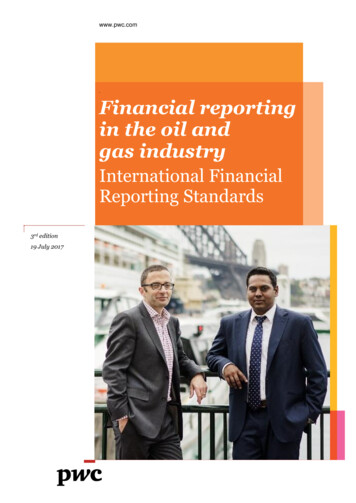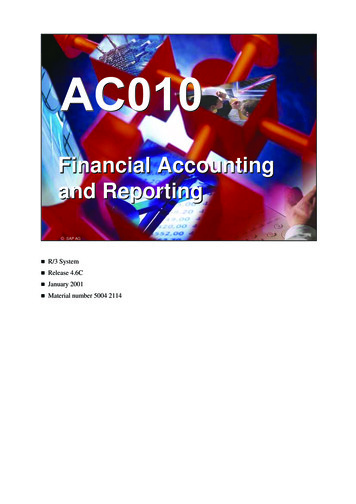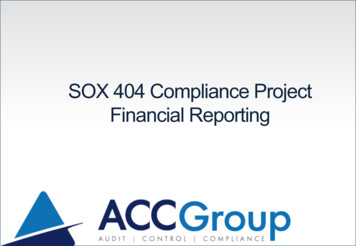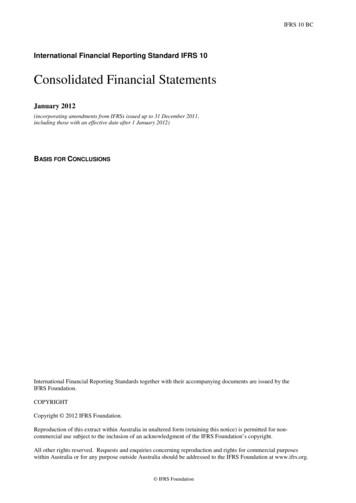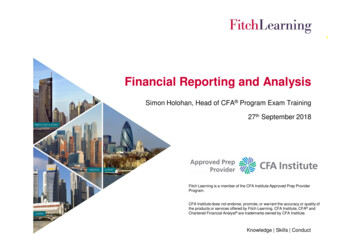
Transcription
Financial Reporting and AnalysisSimon Holohan, Head of CFA Program Exam Training27th September 2018Fitch Learning is a member of the CFA Institute Approved Prep ProviderProgram.CFA Institute does not endorse, promote, or warrant the accuracy or quality ofthe products or services offered by Fitch Learning. CFA Institute, CFA andChartered Financial Analyst are trademarks owned by CFA Institute.Knowledge Skills Conduct
About Fitch LearningFitch Learning has more than 18 years’ experience helping candidates through theirCFA Program studies. Over 3,000 CFA Program candidates study with FitchLearning every year. Choose from a range of flexible classroom and online options Get a personalized learning experience with access to our adaptiveonline study portal – Fitch Learning CognitionKnowledge Skills Conduct
Fitch Learning Cognition Study anytime and anywhere on desktop or using the mobile app Receive guidance through the topics so you know exactly what to study and when Get the support you need from our expert instructor team via the online helpdeskKnowledge Skills Conduct
Getting ready for the Level I CFA Program examMake use of our review resources as you approach the end of your studies and enter the exam hall feelingconfident. 5-Day Intensive Program, starting 8th or 29th October 2-Day Classroom Review courses, (weekday or weekend) available in November Online review including a variety of question tools,workshops, videos and mocks:- Prepare for the exam- Strengthen your knowledge- Perfect your exam technique Stand alone mock exams (online and printable)For more information, contact Steve Brady on 0207 496 8295 or email steve.brady@fitchlearning.com.Alternatively, visit www.fitchexamprep.com/review-options.Knowledge Skills Conduct
CoverageSTUDY SESSION 6: FINANCIAL REPORTING AND ANALYSIS: ANINTRODUCTIONReading AssignmentsReading 21: Financial Statement Analysis: An IntroductionReading 22: Financial Reporting MechanicsReading 23: Financial Reporting StandardsSTUDY SESSION 7: FINANCIAL REPORTING AND ANALYSIS: INCOMESTATEMENTS, BALANCE SHEETS AND CASH FLOW STATEMENTSReading AssignmentsReading 24: Understanding Income StatementsReading 25: Understanding Balance SheetsReading 26: Understanding Cash Flow StatementsReading 27: Financial Analysis Techniques
SS6: FRA: An Introduction
SS7: FRA: Income Statements, Balance Sheets andCash Flow Statement
Reading 21: Financial Statement Analysis: An IntroductionSummary of key financial statements Income statement Balance sheet Statement of cash flows Statement of changes in owners’ equity (including statement of comprehensive income)Summary of additional information Footnotes and supplementary schedules Management’s discussion and analysis (MD&A) External auditor’s report(s)Steps in the Financial Statement Analysis ProcessStep 1 - Articulate the purpose and context of analysisStep 2 - Collect all relevant dataStep 3 - Process dataStep 4 - Analyse results of data processingExpensesStep 5 - Conclude recommendation and communicate thisStep 6 - Follow-up
Reading 22: Financial Reporting MechanicsAssetsLiabilitiesOwners’ equityThe economic resources of a companyThe creditors’ claims on resources of a companyThe residual claim on those resourcesRevenueInflows of economic resources to the companyExpensesOutflows of economic resources from the company or increases in liabilitiesAccountsProvides individual records of increases and decreases in specific asset,liability, component of owners’ equity, revenue or expenseLast year’sbalance sheetIncludes: Cash RetainedearningsStatement of cash flowsIncome statement(Together with Statement of ComprehensiveIncome and Statement of Stockholders’ Equity)This year’sbalance sheetIncludes: Cash Retainedearnings
Reading 23: Financial Reporting StandardsRequired FinancialStatementsBalance sheetIncome statementStatement of changes inequityStatement of cash flowsAccounting policies andnotesFundamentalPrinciplesFair presentationGoing concernAccrual sAggregation whereappropriateNo offsettingClassified balance sheetMinimum information onfaceMinimum notedisclosuresComparative informationStandard setters International Accounting Standards Board (IASB) - IFRS Financial Accounting Standards Board (FASB – US GAAPRegulatory authorities US: Securities Exchange Commission (SEC) UK: Financial Conduct Authority (FCA) and Prudential Regulation Authority(PRA)
Reading 24: Understanding Income StatementsRevenue RecognitionPercentage-ofcompletionCompleted contractProfit recognisedOver the life of thecontractAt the end of ityHigherLowerApproachMore aggressive becauseprofit is recognised earlierLess aggressive
Reading 24: Understanding Income StatementsEarning per share (EPS)CalculationBasic EPSDiluted EPS –convertiblepreference sharesDiluted EPS –convertible bondsDiluted EPS –warrants/ employeeoptionsNet income - preference dividendsWeighted average number of sharesNet incomeWeighted average number of shares New shares issuedNet income - preference dividends post - tax interest savedWeighted average number of shares New shares issuedNet income - preferencedividendsWeightedaveragenumber of shares New dilutivesharesissuedDilutiveshares Av. shareprice - exercisepricex no. of sharesissuedAverageshareprice
Reading 25: Understanding Balance SheetsFinancial AssetsTradingsecuritiesAvailable-for-saleBalance sheetvaluationFair valueFair valueMovements in fairvalue – unrealisedgains/lossesIncomestatementDirect to equity – statementIncome statementHeld-to-maturityAmortized costN/AIncome statement
Reading 26: Understanding Cash Flow StatementsIndirect method Calculation of cash flows from operations (CFO)Organization of statement of cash flowsCash flows from operations (CFO)Net income /- Cash flow from investing (CFI) Non-cash expenses- Non-cash revenues /- Cash flow from financing (CFF) Decreases in accounts receivables/inventories- Increase in accounts receivables/inventories Change in cash account Increase in accounts payable/tax payable/interest payable- Decrease in accounts payable/tax payable/interest payable Beginning period cash Ending cash balance- Gain on disposal of an asset Loss on disposal of an asset Cash flows from operations (CFO)US GAAPIAS GAAPInterest receivedCFOCFO or CFIInterest paidCFOCFO or CFFDividends receivedCFOCFO or CFIDividends paidCFFCFO or CFFBank overdraftsCFFConsidered part of cash andcash equivalentsTaxes paidCFOCFO but some can beallocated to CFI/CFF ifappropriateFormatDirect or indirect,reconciliation if direct is usedDirect or indirect
Reading 27: Financial Analysis TechniquesActivity ratios Days of inventory on hand (DOH) Average inventoryx 365Cost of goods sold Days of sales outstanding (DSO) Average receivablesx 365Revenue Payables days Average payables X 365PurchasesCash conversion cycle DOH DSO – Payable days Total asset turnover RevenueAverage total assets
Reading 27: Financial Analysis TechniquesLiquidity ratios Current ratio Current assetsCurrent liabilities Quick (acid test) ratio Current assets - InventoryCurrent liabilitiesSolvency ratios Debt - to - equity ratio DebtEquity Financial leverage ratio Interest cover Average total assetsAverage total equityEarnings before interest and tax(EBIT)Interest payments
Reading 27: Financial Analysis TechniquesPerformance ratiosReturn on equityROE Net incomeAverage shareholders' equityROE ROA x LeverageTwo-stage DuPont Net incomeAverage total assetsxAverage total assets Average shareholders' equityROE Net profit margin x Asset turnover x LeverageThree-stage DuPontFive-stage DuPontROE ROE EATRevenue AssetsxxRevenueAssetsEquityEAT EBTEBITREVENUE ASSETSxxxxEBT EBIT REVENUEASSETSEQUITY
CoverageSTUDY SESSION 8 – FINANCIAL REPORTING AND ANALYSIS: INVENTORIES,LONG-LIVED ASSETS, INCOME TAXES, AND NON-CURRENT LIABILITIESReading AssignmentsReading 28: InventoriesReading 29: Long-Lived AssetsReading 30: Income TaxesReading 31: Non-Current (Long-Term) LiabilitiesSTUDY SESSION 9 – FINANCIAL REPORTING AND ANALYSIS: FINANCIALREPORTING QULAITY AND FINANCIAL STATEMENT ANALYSISReading AssignmentsReading 32: Financial Reporting QualityReading 33: Financial Statement Analysis: Applications
SS8: FRA: Inventories, Long-lived Assets, Income Taxes,and Non-current Liabilities
SS9: Evaluating Financial Quality And FinancialStatement Analysis
Reading 28: InventoriesAccounting for inventories and the cost of goods soldBeginning inventory (BI)Inventory methods: In periods of rising prices and stable orincreasing inventory levelsFIFOLIFOInventoryHigherLowerShareholder equityHigherLower Purchases (P)EarningsHigherLower Cost of goods available to sellPre-tax cash flowSameSameAfter-tax cash flowLowerHigherProfit marginsHigherLowerAsset turnoverLowerHigherCurrent ratioHigherLowerDebt to equityLowerHigher- Ending inventory (EI) Cost of goods sold (COGS)LIFO ReserveBalance SheetIncome gsLIFOReservex (1 – t)FIFONetIncomeLIFONetIncome
Reading 29: Long-Lived AssetsCapitalisingWhere cash outflows are considered to provide benefits in the future, typically beyond one year, the spending can be capitalisedDecrease cashIncrease assets (PPE or intangibles)Further adjustmentsDepreciation/amortizationExpensingWhere the outflow is not expected to provide a benefit for future periods the amount is deducted from Net Income in the periodand therefore expensedDecrease cashDecrease equityWhere spending is expensed in the period incurred, no further charges to income are requiredDepreciation methodsEffect of depreciation choices on key financial ratios Straight line vs. accelerated methods (early years of asset life) Straight line Cost of asset allocated to expense evenly over itsuseful lifeDepreciation expense Cost Estimated residual (salvage) valueUseful life (UEL) Accelerated methods Allocation of cost is greater in earlier years Double declining balance:Depreciation expense Constant % x Undepreciated costConstant % 2 / Useful lifeUndepreciated cost Cost – Accumulated depreciationInstructor Tip:“The calculator has the function that can calculateddepreciation for you! Take a look at the calculatorrecording on Cognition”VariableStraight rShareholders’ equityHigherLowerCash flowSameSameProfit margin (profit/revenue)HigherLowerCurrent ratio (CA/CL)SameSameAsset turnover (revenue/assets)LowerHigherDebt-to-equity (debt/equity)LowerHigherReturn-on-assets (NI/assets)HigherLowerReturn-to-equity (NI/Equity)HigherLower
Reading 29: Long-Lived AssetsUS GAAPIFRSReversal of impairment ofinventoryNot allowedPermittedReversal of impairment of longlived assets held for useNot allowedPermittedReversal of impairment of longlived assets held for salePermittedPermittedReversal of impairment ofintangible assets other thangoodwillNot allowedPermittedReversal of impairment ofgoodwillNot allowedNot allowedRevaluation of long-lived assetsNot allowedPermittedRevaluation of goodwillNot allowedNot allowed
Reading 30: Income TaxesDifferences between accounting profit and taxable income Permanent differences Income or expenses are included in either pre-tax income or taxableincome but not both Temporary differences Income or expenses are included in both pre-tax income and taxable income but in different periods: Warranty expense Accounting depreciation methods vs. tax depreciation methods Tax lossesIncome tax expense in income statementIncome TaxExpenseIncrease in DTLIncome TaxesOwedDeferred tax liabilities (DTL) Pre-tax income taxable incomeIncrease in DTABalance sheetitemCarrying amount vs. tax baseDTL/DTL Difference due to a temporary timing difference E.g. accelerated tax depreciation vs. accounting depreciationAssetCarrying amount tax baseDTLDeferred tax assets (DTA)AssetCarrying amount tax baseDTALiabilityCarrying amount tax baseDTALiabilityCarrying amount tax baseDTL Pre-tax income taxable income E.g. accounting expenses not being recognized for taxpurposes such as warranty expense Tax losses
Reading 31: Non-Current (Long-Term) LiabilitiesAccounting for bondsSummary Date of issue Recognize present value of liability on balance sheet Bonds issued at par Market rate Coupon rate Interest expense Coupon payment Interest expense Opening liability x Yield at date of issue Bonds issued at a discount to par value Market rate Coupon rate Interest expense Coupon payment Liability in balance restExpenseBondCouponPaid inthe PeriodOpening Liabilityx Interest rate Cash flow statement Coupons CFO (IFRS CFO/CFF) Proceeds/repayment of principal CFFAmortisationof DiscountNonCashClosingLiability Zero-coupon bonds Market rate Coupon rate Interest expense Coupon payment Interest expense Amortization of discount Bonds issued at a premium to par value Market rate Coupon rate Interest expense Coupon paymentInterestExpenseCouponCashAmortisationof DiscountNonCash
Reading 31: Non-Current (Long-Term) LiabilitiesFinance (or capital) lease vs. operating lease Finance leases are recognized on balance sheet Operating leases are treated like a rental No asset or liability recognized on balance sheet Rental expense recognized in income statementAccounting for a finance lease Amortized cost method Recognize asset and liability on balance sheet Present value of minimum lease paymentsLeasesIFRS criteria for recognizing a finance lease Lease transfers ownership of asset to lessee by end of lease term,or Lessee has option to purchase asset at less than fair value, or Lease term is for major part
Financial Reporting and Analysis Simon Holohan, Head of CFA Program Exam Training 27th September 2018 Fitch Learning is a member of the CFA Institute Approved Prep Provider Program. CFA Institute does not endorse, promote, or warrant the accuracy or quality of the products or services offered by Fitch Learning. CFA Institute, CFA and
